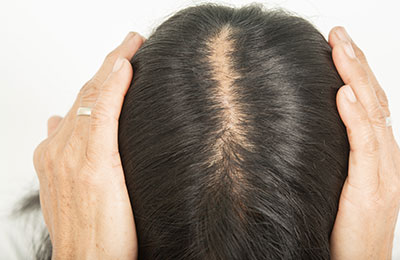NeoGraft Hair Restoration Rehoboth Beach
Hair loss, baldness or alopecia refers to abnormal or excessive hair loss from your scalp. Androgenetic alopecia is the most common cause of baldness seen in both men and women that is the result of a combination of genetic and environmental factors that center around increased androgen hormone levels associated with aging, some ovarian cysts, medications including birth control pills, pregnancy and menopause. Fortunately, this form of baldness can be treated.
Some people allow their progressive hair loss to run its course without treatment and left unhidden. Other people may cover their hair loss with hairstyles, makeup, hats or scarves. Another approach for camouflaging large areas of baldness include wigs, natural or synthetic or concealing powders, lotions or sprays. Unfortunately, some of these attempted hairstyles or synthetic remedies may worsen the baldness.
Finally, many people will seek other “medical” solutions that would prevent further hair loss and restore grow of new hair including medications, oral or topical, lasers, injection with platelet rich plasma or hair transplantation surgery.
Hair loss will present in different ways
Gradual hair thinning on top of head: This is the most common pattern of hair loss seen in both men and women as they age. This gradual form of hair loss is a hereditary condition called male pattern baldness or female pattern baldness.

In men, the hair thinning begins at the forehead and recedes in a line that resembles the letter M.

Women tend to maintain their frontal hairline (forehead) but have a widening in the part of their hair.
Treatment Options: topical and oral medications, lasers, platelet rich plasma injections (PRP) , hair transplantation.
 Patchy hair loss (alopecia areata): This form of baldness is an autoimmune disorder where your immune system attacks your hair follicles. Some people will experience large coin sized bald spots across the scalp and sometimes eyebrows or beards. You might also note itchy skin or discomfort before experiencing hair loss. Hair transplantation is NOT indicated.
Patchy hair loss (alopecia areata): This form of baldness is an autoimmune disorder where your immune system attacks your hair follicles. Some people will experience large coin sized bald spots across the scalp and sometimes eyebrows or beards. You might also note itchy skin or discomfort before experiencing hair loss. Hair transplantation is NOT indicated.
 Sudden loss of hair with diffuse hair loss (not patchy): A physical or emotional stress can cause hair loss which can be temporary and reversed if recognized and treated early. Handfuls of hair may come out with hair brushing, combing, washing or even gentle tugging. Traction alopecia is a result of excessive hairstyles that pull your hair tight. Hot oil hair treatments and other chemicals can cause inflammation leading to hair loss. Treatment: hair loss is usually reversible if physical or emotional stress is removed. Physical shock with radiation therapy to the back of the head or hot oil/chemicals to hair creating scarring might produce permanent hair loss
Sudden loss of hair with diffuse hair loss (not patchy): A physical or emotional stress can cause hair loss which can be temporary and reversed if recognized and treated early. Handfuls of hair may come out with hair brushing, combing, washing or even gentle tugging. Traction alopecia is a result of excessive hairstyles that pull your hair tight. Hot oil hair treatments and other chemicals can cause inflammation leading to hair loss. Treatment: hair loss is usually reversible if physical or emotional stress is removed. Physical shock with radiation therapy to the back of the head or hot oil/chemicals to hair creating scarring might produce permanent hair loss
Full body hair loss: some conditions and medical treatments such as medications for various illnesses and chemotherapy for cancer can produce hair loss all over your body. Treatment: hair usually grows back once these treatments are stopped
 Patches of scaling that spread across the scalp: Ringworm is a type of fungal infection that causes hair loss, disrupted hair follicles, redness, swelling and sometimes oozing of the scalp. Treatment: oral medications and medicated shampoos to eradicate the fungus.
Patches of scaling that spread across the scalp: Ringworm is a type of fungal infection that causes hair loss, disrupted hair follicles, redness, swelling and sometimes oozing of the scalp. Treatment: oral medications and medicated shampoos to eradicate the fungus.
Treatment of Androgenetic Alopecia: Male pattern baldness and female pattern baldness
- Medications: Minoxidil topical and finasteride oral are the only two drugs that currently have FDA approval for treatment of androgenetic alopecia. Minoxidil shampoo acts by increasing blood flow to hair follicles and appears more effective on the top of the scalp. Oral finasteride has been shown to improve hair growth on the top of the scalp as well as the frontal scalp in men (not women). Other medications include ketoconazole (anti fungal) shampoos, topical finasteride (for men) and progesterone (for women) sprays.
-
Low light laser therapy(red light therapy) has been shown to improve overall hair growth through increased blood flow to the hair follicles
Platelet Rich Plasma (PRP) has been shown to be effective in the treatment of androgenetic alopecia. When injected into areas of thinning scalp, PRP will stimulate hair growth by increasing anagen hair follicles (actively growth) and decreasing telogen hair follicles (at rest). - Surgery: Hair transplant follicular unit extraction (FUE) procedure involves transplanting very tiny patches of hair follicles from the back of your scalp and relocating them to areas of baldness or hair thinning. The analogy is similar to transplanting some of your tulips in the backyard to your front yard to make your home look more attractive.
There are other types of hair restoration procedures including strip method hair transplantation, flap surgery, tissue expansion of the scalp and scalp reduction surgery.
The strip method has the advantage of transplanting a greater number of hair follicles at the cost of a potentially long unsightly scar as well as longer recovery. The final hair results between follicular unit extraction (FUE) versus strip method is the same.
FAQs
-
Am I a good candidate for a hair transplant procedure?
- You are bothered by progressive loss and thinning of your hair
- The cause of your hair loss has been determined to be treatable: Androgenetic alopecia (most common), traumatic scars
- In some cases, there is a desire to add additional hair to areas of the body such as creating a beard, moustache or increase chest hair
- You are in good medical condition, a nonsmoker and have a complete understanding of the procedure and risks
- You have realistic expectations and understand importance of long term hair maintenance with combination topical sprays/shampoos, oral medications and/or laser helmet
-
What should I expect at my hair transplant consultation?
- Listening to your hair loss concerns, goals and expectations of final outcome
- Obtaining general medical history, medications, allergies, previous surgeries, exposure to smoking
- Any prior hair rejuvenation treatments: medications, lasers, PRP, previous hair transplants
- Examination of hair loss pattern, hair quality and thickness, donor site availability, scars
- Photographs taken
- Determine you are a good candidate for treating your hair loss: androgenetic alopecia, scar alopecia
- Discuss all options for hair rejuvenation
- Outline a treatment plan for your hair rejuvenation
- Discussion of details, risks, recovery and expected outcome of your hair transplant procedure
-
What are the risks associated with Follicular Unit Extraction (Neograft) hair transplant procedure?
- The Overall risks are quite low
- Swelling
- Temporary Discomfort
- Infection is Uncommon
- Scabbing
- Tiny white scars back of head seen close up only with short hair
- Hair loss – natural process if maintenance care not followed
- Cysts – small bumps from ingrown hair follicles
- Itching
-
What should I expect from the Neograft hair transplant procedure?
- Neograft hair transplantation is an office based procedure performed under local anesthesia
- Depending upon how hair grafts transplanted, the procedure lasts around six hours
- Neograft is an automated hair transplant system which facilitates the harvesting of micro hair follicles in 1-, 2- and 3- follicle patches during a Follicular Unit Extraction (FUE) hair transplant that dramatically improves accuracy and speed over previous manual extraction techniques. The harvesting of these micrografts enables the technician to create a very naturally appearing hairline that avoids any visible scars or cobbling seen with older techniques
- No aspirin or blood thinners 7-10 days prior to procedure
- The day prior your procedure, have a level 1 haircut high and tight including back and sides but may leave frontal and top of hair alone
- May eat a light meal on the day of the procedure
- Wear comfortable clothing with button shirt
- An oral antibiotic is given just before the start of the procedure. Upon request, oral Valium and/ narcotic is given
- Photographs taken
- The expected hair design is outlined to patient’s approval
- Local anesthesia is given
- Sterile soap to clean all treated areas
- In the face down position on a spa table, Neograft device is used to harvest the necessary hair follicles
- Hair follicles are prepared on the back table in Petri dishes separating them into 1-, 2- and 3- follicle micrografts
- In the sitting position, tiny openings made with an 18 gauge needle are created along the new design hairline and other areas of hair loss to be treated. These tiny openings are meticulously placed at proper angles to create a very natural hairline and orientation
- Brief 20 minute late morning lunch break
- Final stage of the hair transplant procedure in a comfortable reclining position where patient can view the TV screen for distraction
- Careful placement of hair follicle micrografts placing the single follicle grafts in front and blending the 2- and 3- follicle micrografts towards the back
- Head band placed upon completion with a loose surgical bouffant cap. Recommend keeping headband in place 3-5 days to minimize facial swelling
- Discharge home with a responsible adult with instructions
- Spritz hair gently and continuously with saline spray first 48-72 hours and on a daily basis first 1-2 weeks
- Sleep in a reclining chair with an airplane pillow first 48-72 hours
- May shower the next day but avoid direct water on treated scalp first 2 weeks
- May wet treated scalp in the shower on the following day with a small Dixie cup of warm water with Johnson’s baby shampoo
- May wear a loose high baseball cap after 1 week
- No strenuous exercise for 2 weeks
- May walk and drive a car the next day
- Resume minoxidil shampoo and laser helmet after 4 weeks
- May apply hair conditioner to treated scalp after 2 weeks to light remove dry scabs
- Expect to lose most of transplanted hair follicles (the shaft) about one month after the procedure but will see new hair growth starting at 3 months and final results at one year
- The results of your hair transplant procedure depends on how well you manage your hair with shampoos, laser helmet and possible future PRP injections

 Hair Restoration – Part 1
Hair Restoration – Part 1 Hair Restoration – Part 2
Hair Restoration – Part 2 Hair Restoration – Part 3
Hair Restoration – Part 3 Hair Restoration – Part 4
Hair Restoration – Part 4 Hair Restoration – Part 5
Hair Restoration – Part 5 Hair Restoration – Part 6
Hair Restoration – Part 6






